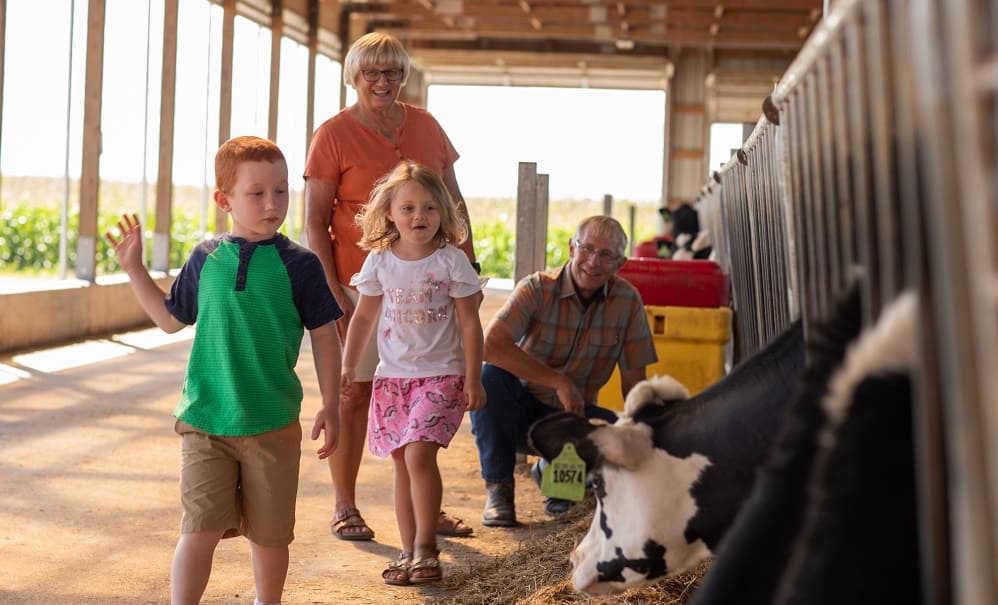Calcium for dairy cows. If you are a dairy farmer, there is no other mineral you spend as much time thinking about or stressing over than calcium. When the effects of low blood calcium can lead to down cows, dystocia, uterine prolapse, retained placenta, mastitis, displaced abomasum, lower milk production, higher ketosis risk and decreased reproductive performance, there is good reason to be concerned about lack of this common mineral in your cows’ systems.
We recently talked with four individuals about their solutions to the calcium problem and how calcium supplementation has become standard in their operations.
Matthew Koppes
Koppes Dairy Farms, Monmouth, Iowa
Milking 260 cows
Savador Robtredo
Newberry Farms, Rensselaer, Indiana
Milking 3,000 cows
Jason James
Pine-Valley Farm, Mineral Point, Wisconsin
Milking 170 cows
Siebren Jacobi
Rocking S Dairy, Modesto, California
Milking 3,100 cows
What is your calcium protocol?

All fresh cows get a dose (2 boluses) of RumiLife® CAL24™ within two to four hours of calving. They must have RumiLife® CAL24™ before their first post-calving milking.

All cows in their third lactation and up receive a dose of RumiLife® CAL24™ immediately after calving. Cows in their fourth lactation and up receive another dose after 12 hours.

All fresh cows in their second lactation or greater get a dose of RumiLife® CAL24™ at freshening.

Beginning with their second lactation, all cows get two boluses at calving. Eight to 24 hours hours after calving they are given another bolus. If they have a retained placenta, are over-conditioned or had twins, two boluses are administered. If a cow stays in the fresh/hospital pen for more than one day, she receives another bolus on her way out. With this protocol, calcium is not the weakest link.
What did you do prior to the aforementioned protocols?

We used a competitor product. We don’t have headlocks, so the ease of one dose is what sold us. We also like the added magnesium in RumiLife® CAL24™. We saw that cows were now cleaning within an hour of giving birth.

Used another calcium product.

We used supplemental calcium on an as-needed basis.

I started using RumiLife® CAL24™ when it first came on the market. Before that I was using another calcium product.
What prompted you to make a change?

The ease of one dose and the added magnesium.

We heard about the results from people using RumiLife® CAL24™.

We believed industry research pointing to a need for calcium supplementation. All our cows will benefit and realize health advantages post-calving.

After learning more about subclinical milk fever, I liked that RumiLife® CAL24™ provided 24 hour calcium coverage.
Have you noticed any transition cow health differences since making the change?

Since making the change, we have seen great fresh cow health, with less retained placentas and metritis. We feel the cows get off to a smoother transition post-calving, which is critical. When fresh cows transition smoothly, they roll right into being a contributing member of the production herd.

We have noticed a lot less clinical milk fever cases and less retained placentas. We have also noticed increased milk production.

Cows are peaking higher and showing heats sooner, pointing to a smooth transition.

Now, every normal cow now goes through the transition period with no retained placentas, no infusing, no metritis, no metabolic issues. After being on my current protocol, we no longer do fresh pen checks. We just leave the cows alone. I believe this protocol helps us to be able to successfully milk 90% of our mature cows 4 times a day.
Are you new to the RumiLife® CAL24™ nutritional supplement product? Our uniquely formulated bolus product promotes calcium levels in fresh cows. Our unique once-and-done solution means no more waiting 12 hours to catch a cow for a second calcium bolus. So you can delete that second bolus reminder, stress less about calcium, and spend more time with those who matter!

For product availability outside the USA, please check with your local GENEX retail center or GENEX distributor.


